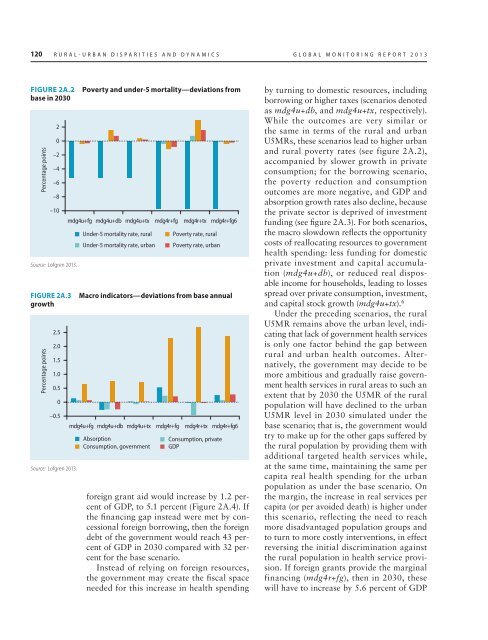rural-urban dynamics_report.pdf - Khazar University
rural-urban dynamics_report.pdf - Khazar University
rural-urban dynamics_report.pdf - Khazar University
You also want an ePaper? Increase the reach of your titles
YUMPU automatically turns print PDFs into web optimized ePapers that Google loves.
120 RURAL-URBAN DISPARITIES AND DYNAMICS GLOBAL MONITORING REPORT 2013<br />
FIGURE 2A.2<br />
base in 2030<br />
Percentage points<br />
2<br />
0<br />
–2<br />
–4<br />
–6<br />
–8<br />
–10<br />
Source: Lofgren 2013.<br />
FIGURE 2A.3<br />
growth<br />
Percentage points<br />
2.5<br />
2.0<br />
1.5<br />
1.0<br />
0.5<br />
0<br />
–0.5<br />
Source: Lofgren 2013.<br />
Poverty and under-5 mortality—deviations from<br />
mdg4u+fg mdg4u+db mdg4u+tx mdg4r+fg mdg4r+tx mdg4r+fg6<br />
Under-5 mortality rate, <strong>rural</strong><br />
Under-5 mortality rate, <strong>urban</strong><br />
Poverty rate, <strong>rural</strong><br />
Poverty rate, <strong>urban</strong><br />
Macro indicators—deviations from base annual<br />
mdg4u+fg mdg4u+db mdg4u+tx mdg4r+fg mdg4r+tx mdg4r+fg6<br />
Absorption<br />
Consumption, private<br />
Consumption, government GDP<br />
foreign grant aid would increase by 1.2 percent<br />
of GDP, to 5.1 percent (Figure 2A.4). If<br />
the financing gap instead were met by concessional<br />
foreign borrowing, then the foreign<br />
debt of the government would reach 43 percent<br />
of GDP in 2030 compared with 32 percent<br />
for the base scenario.<br />
Instead of relying on foreign resources,<br />
the government may create the fiscal space<br />
needed for this increase in health spending<br />
by turning to domestic resources, including<br />
borrowing or higher taxes (scenarios denoted<br />
as mdg4u+db, and mdg4u+tx, respectively).<br />
While the outcomes are very similar or<br />
the same in terms of the <strong>rural</strong> and <strong>urban</strong><br />
U5MRs, these scenarios lead to higher <strong>urban</strong><br />
and <strong>rural</strong> poverty rates (see figure 2A.2),<br />
accompanied by slower growth in private<br />
consumption; for the borrowing scenario,<br />
the poverty reduction and consumption<br />
outcomes are more negative, and GDP and<br />
absorption growth rates also decline, because<br />
the private sector is deprived of investment<br />
funding (see figure 2A.3). For both scenarios,<br />
the macro slowdown reflects the opportunity<br />
costs of reallocating resources to government<br />
health spending: less funding for domestic<br />
private investment and capital accumulation<br />
(mdg4u+db), or reduced real disposable<br />
income for households, leading to losses<br />
spread over private consumption, investment,<br />
and capital stock growth (mdg4u+tx). 6<br />
Under the preceding scenarios, the <strong>rural</strong><br />
U5MR remains above the <strong>urban</strong> level, indicating<br />
that lack of government health services<br />
is only one factor behind the gap between<br />
<strong>rural</strong> and <strong>urban</strong> health outcomes. Alternatively,<br />
the government may decide to be<br />
more ambitious and gradually raise government<br />
health services in <strong>rural</strong> areas to such an<br />
extent that by 2030 the U5MR of the <strong>rural</strong><br />
population will have declined to the <strong>urban</strong><br />
U5MR level in 2030 simulated under the<br />
base scenario; that is, the government would<br />
try to make up for the other gaps suffered by<br />
the <strong>rural</strong> population by providing them with<br />
additional targeted health services while,<br />
at the same time, maintaining the same per<br />
capita real health spending for the <strong>urban</strong><br />
population as under the base scenario. On<br />
the margin, the increase in real services per<br />
capita (or per avoided death) is higher under<br />
this scenario, reflecting the need to reach<br />
more disadvantaged population groups and<br />
to turn to more costly interventions, in effect<br />
reversing the initial discrimination against<br />
the <strong>rural</strong> population in health service provision.<br />
If foreign grants provide the marginal<br />
financing (mdg4r+fg), then in 2030, these<br />
will have to increase by 5.6 percent of GDP

















